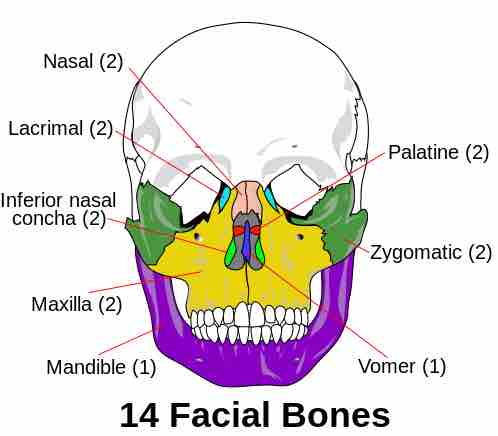The viscerocranium or facial bones supports the soft tissue of the face. The viscerocranium consists of 14 individual bones that fuse together. The hyoid bone, ethmoid bone, and sphenoid bones are sometimes included in the viscerocranium.
The two zygomatic bones form the cheeks and contribute to the orbits. They articulate with the frontal, temporal, maxilla, and sphenoid bones.
The two lacrimal bones form the medial wall of the orbit and articulate with the frontal, ethmoid, maxilla, and inferior nasal conchae. The lacrimal bones are the two smallest bones located in the face.
The two slender nasal bones located in the midline of the face fuse to form the bridge of the noise and also articulate with the frontal, ethmoid and maxilla bones. The inferior nasal conchae are located within the nasal cavity. They are spongy and curled in shape; their primary function is to increase the surface area of the nasal cavity, which also increases the amount of air that contacts the mucous membranes and cilia of the nose, thus filtering, warming, and humidifying the air before it enters the lungs. At the base of the nasal cavity is the small vomer bone which forms the nasal septum.
The maxilla bones fuse in the midline and form the upper jaw. They provide the bed for the upper teeth, the floor of the nose, and the base of the orbits. The maxilla articulates with the zygomatic, nasal, lacrimal, and palatine bones.
The palatine bones fuse in the midline to form the palatine, located at the back of the nasal cavity that forms the roof of the mouth and the floor of the orbit.
Finally, the mandible forms the lower jaw of the skull. The joint between the mandible and the temporal bones of the neurocranium, known as the temporomandibular joint, forms the only non-sutured joint in the skull.

Facial bones
There are fourteen facial bones. Some, like the lacrimal and nasal bones, are paired. Others, like the mandible and vomer, are singular.